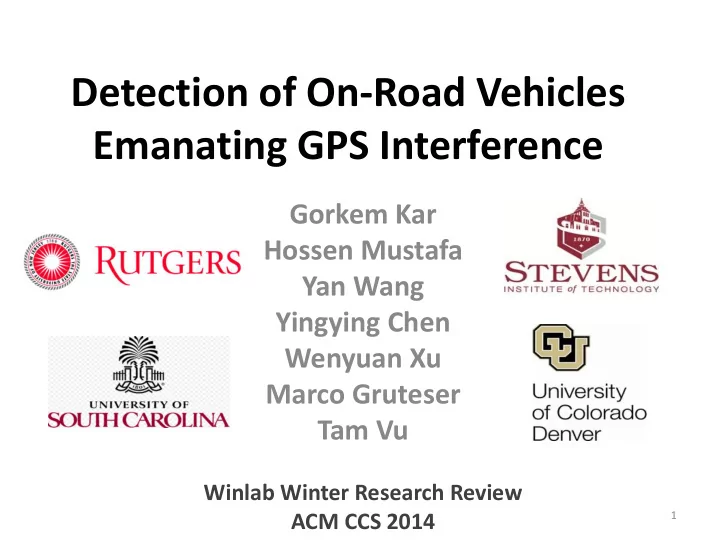

Detection of On-Road Vehicles Emanating GPS Interference Gorkem Kar Hossen Mustafa Yan Wang Yingying Chen Wenyuan Xu Marco Gruteser Tam Vu Winlab Winter Research Review ACM CCS 2014 1
GPS in Critical Infrastructures 2
GPS Jammers 3
Newark Airport Incident • In 2010, ground GPS receivers did not work for a few minutes repeatedly over couple of months. • It took 3 months to locate the problem. 4
Current Solutions • Handheld devices – Works only in static scenarios – Used manually for a short time • Standard wireless localization techniques – Not sufficient to pinpoint a vehicle in dense traffic What is needed? 5
What is Needed? • A detection and identification system that is; – automated, with high accuracy, and at a low cost, 6
Overview of Jamming Detection System Monitoring Point Mobile Phone Jammer 7
Multiple Monitoring Points Jammer is detected with MP1 @ time t1 MP 2 MP 1 8
Multiple Monitoring Points Jammer is detected with MP2 @ time t2 MP 2 MP 1
Monitoring Points 10
Experimental Setup USRP 11
MP Location Camera Monitoring Point 12
Detection Zone 13
Identified Vehicle Positions at t m (m) (m) 14
Single Monitoring Point Case @ MP 2 @ MP 1 We could uniquely identify the transmitting car with 65% @ MP 1 and 35% @ MP 2 with NO false positive rate. 15
Multiple Monitoring Case • The detection rate can be improved by combining the information collected from both zones . – Intersect the candidate vehicle sets @ MP1 and MP2. This resulted in only a single detected vehicle and a correct identification of our transmitter vehicle in all cases . 16
Passive Roadside Monitoring • 5 locations are chosen in NJ and SC; 200 hours of monitoring passively, – a major highway, – one of the busiest toll road, – and an urban road • Two suspicious interference incidents are detected. • May not come from real jammer, but still proves the interference exist @ L1 frequency band (which is GPS band, 1.5 GHz). 17
Mobile Detectors 18
How to Detect the Interference via Mobile Phones? Profiling – Use Android API to get the current Average SNR (dB) SNR(Signal-to-Noise Ratio) value of the location – Create a SNR profile of a sample route by matching SNR with GPS position (expected SNR) Anomaly Detection – Compare current reading(SNR) of the mobile detector with the expected SNR from profiling stage – If current reading of SNR is lower than the expected SNR, there should be an interference at L1 freq., central office should be notified. 19
Conclusion • Presented a low-cost jammer identification system that can be mass deployed in roadways to automatically detect and identify the vehicles with GPS jammers. • The key components of the system are monitoring stations and mobile detectors. • Our mobile detector can detect interfering signals based on measurements that are readily available in most GPS receivers – Thus, it is possible to detect jammers via crowdsourcing. 20
THANKS! • Any questions?
Recommend
More recommend